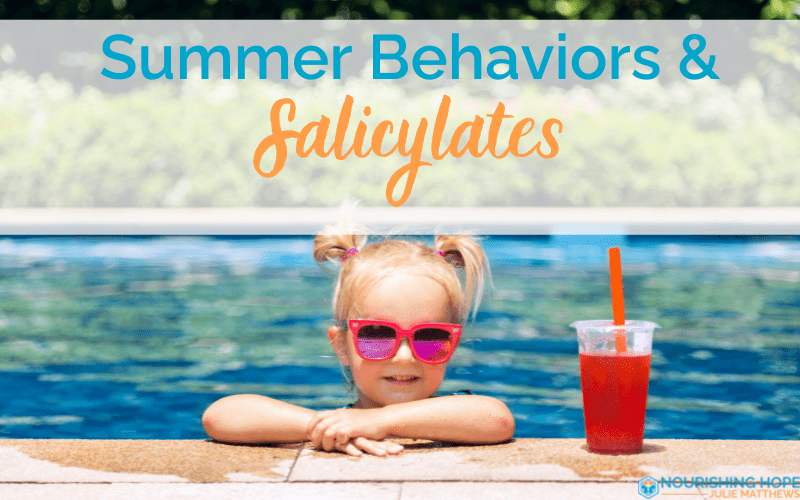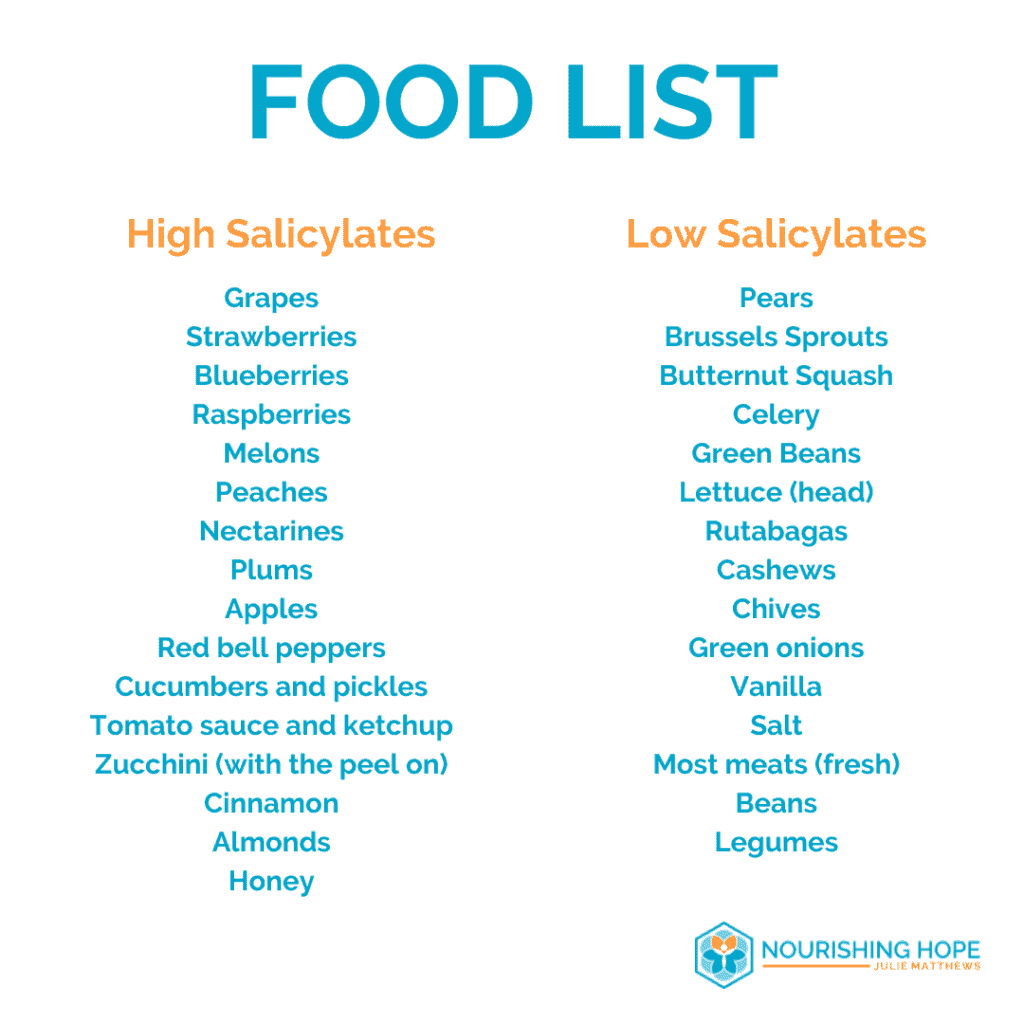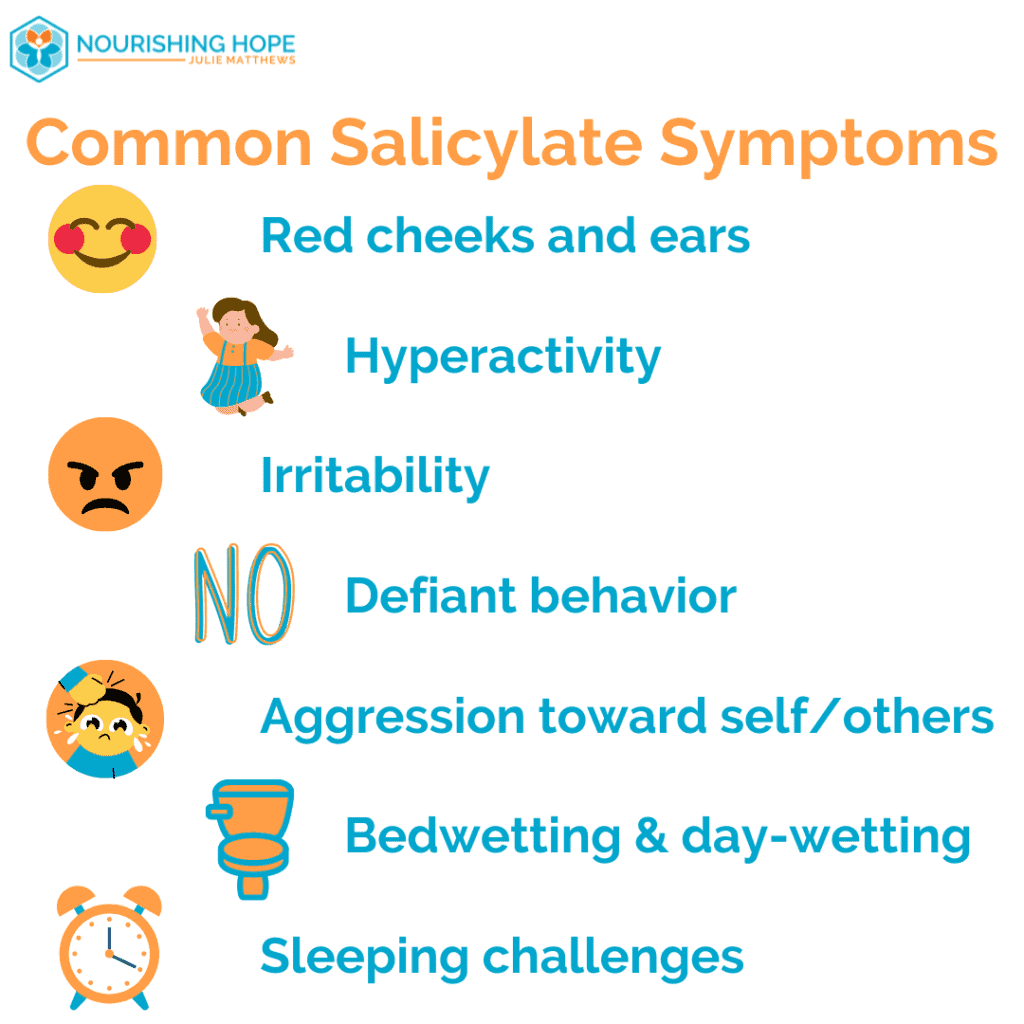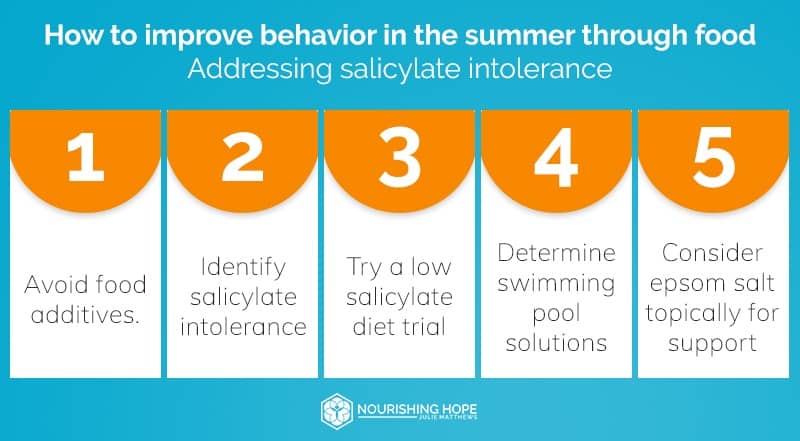
If you expected summertime—free of school, full of fresh air and sunshine—to help your child feel better and behave more calmly, but instead you’re seeing more struggles, salicylates might be the reason.
Salicylates in Food
Salicylates are naturally-occurring food chemicals in fruits, vegetables, and other plant foods like herbs, spices, nuts, etc. In the 1950’s and 60’s, Dr. Ben Feingold observed that artificial additives and high salicylate foods cause hyperactivity and other symptoms in some children. Biochemically, salicylates are a type of “phenolic acid” or “phenol.” Phenols need to be broken down in the body, i.e. “detoxified,” which occurs through a process called sulfation.
For children with salicylate sensitivity, summer can be particularly challenging because so many of the abundant summertime fruits are very high in salicylates.

Summer Fruits High in Salicylate
- Apple
- Apricot
- Avocado
- Blueberries
- Blackberries
- Boysenberries
- Cherries
- Cinnamon and spices
- Cucumbers and pickles
- Currants
- Dates
- Grapefruit
- Grapes
- Figs
- Honey
- Kiwi
- Melons
- Mulberries
- Nectarines
- Orange
- Passionfruit
- Peaches
- Pineapple
- Plums
- Raspberries
- Starfruit
- Strawberries
- Tomato
- Tomato sauce
- Watermelon

Many of these foods are delicious and plentiful, children eat quite a bit more during summer than any other time. The resulting increase in salicylate consumption can cause a child’s body to become overloaded, and cause physical, emotional, and behavioral symptoms.
Food Additives
Junk food with artificial additives are more plentiful during summer. Artificial additives—like food dyes (Red 40, Blue 1, Yellow 5), flavors (artificial strawberry, vanillin), and preservatives (BHA, BHT, TBHQ)—are strong phenols that require the same detoxification pathways.
If you avoid these additives—great job. They’re best left out of any diet.
In the average American family, however, blue-colored sports drinks on hot days, cotton candy from the beach boardwalk or fair, shaved ice or blended slushies from the amusement park are all too common occurrences (sadly). Alone they are known to cause hyperactivity, combined with these other stressors and they can be particularly problematic.
Salicylate Symptoms
While symptoms vary by individual, here are some of the most commonly observed signs of salicylate sensitivity:
Behavioral and Neurological Symptoms
- Hyperactivity
- Irritability
- Defiant behavior
- Anger
- Aggression toward self or others
- Cries and gets upset easily
- Anxiety
- Sadness or depression
- Mood swings
- Short attention span
- Inattentive
- Poor self-control
- Restlessness
- Poor concentration
- Rage
- Rapid, extreme changes in mood
- Math, spelling, and reading difficulty
- Disordered sensory processing
- Slow information processing
- Auditory processing challenges
While this article focuses on the behavioral ramifications of salicylate sensitivity, there can also be common physical symptoms which can help you as a parent or caregiver really pinpoint whether what you are seeing is a reaction to salicylates. Together, these two lists can broaden the picture as to whether your child is salicylate sensitive and could benefit from dietary intervention.
Physical Symptoms
- Red cheeks and ears (not from the heat)
- Bedwetting and day-wetting accidents
- Sleeping challenges
- Asthma
- Headaches or migraines
- Stomach aches
- Hives or itchy skin
- Eczema
- Rashes and dry skin
- Constipation
- Diarrhea
- Congestion
- Rhinosinusitis
- Racing pulse

If you’d like more information on how these foods can cause behavior challenges, along with the foods to avoid and those to eat, see my post on salicylates and behavior challenges.
Additional, yet lesser seen, symptoms can include tics, stammering, tinnitus, and even vertigo. So this is another reminder, if your child’s diet changes or you find they are eating certain foods or food compounds more frequently and new behaviors emerge or old ones return, it is worth it to do a diet review.
Chlorine in Swimming Pools
Chlorine from the swimming pool is another summertime stressor. Your child doesn’t even need to drink the water, just soaking in a chlorinated pool will cause it to absorb into the body.
Chlorine is processed by the same sulfation pathway as salicylates in fruits. Sulfation—the detox process the body uses to handle salicylates—relies on many nutrients and biochemical pathways (methylation and transulfuration). When overloaded, these pathways can’t keep up, leading to symptoms.
Each of these stressors (the fruit and chlorine) will deplete the sulfate and detoxification pool further, making each that much more difficult to handle. After working with many children with autism in my nutrition practice, I’ve found that most react poorly to chlorine from swimming pools. Add this fruit consumption to chlorine from swimming pools, and a child can fairly easily hit “overload.” Crying, meltdowns, increase in stimming, and hyperactivity can result.
High Salicylate Food Substitutes
I hope this summer is better than ever. Here are some ideas to get you off to a good start. The following foods high in salicylates and for lower salicylate substitutions.
Please note: it might not be that you or your child can’t have ANY high salicylate summer fruits and veggies, it might just mean you have to pay attention to the amount and limit it, along with avoiding all artificial additives. Also, peeling certain fruits and vegetables can lower salicylate levels.

Knowing what healthier swaps you can make is important. Salicylate tolerance is personal. Some people are moderately intolerant and some are very sensitive. So the recommendations below will vary depending on the individual.
Artificial additives can be particularly problematic. So, instead of a blue sports drink you can pick a natural electrolyte drink without artificial colors. . Rather than buying artificial flavored candy you can find natural ones. Traditional shaved ice can be very high in both salicylates and sugar. You can buy your own shaved ice machine and use pear juice to flavor. Instead of standard Popsicles or freezer pops you can make your own with pear juice or other tolerated juice.Instead of commercial ice pops, you can make your own using low salicylate fruits and vegetables.
Also, the peel of the fruit or vegetable often contains a lot of salicylates so for some people that have a moderate intolerance, peeling cucumbers and zucchini may provide a sufficient reduction in salicylates.
And salicylates are cumulative, so you can start by focusing on reducing the servings or serving sizes of those high salicylate fruits.

What Can You Do?
- Avoid food additives. Firstly, if your child eats artificial additives, cut them all out.
- Identify salicylate intolerance: If you want to determine if your child may have an intolerance to salicylates, start by simply observing your child within the hour after they eat, and before bedtime—making correlations with high salicylate consumption. The best way to determine salicylate intolerance is to avoid high salicylate foods for a period of time and observe any improvements, and then add them back and see if you notice a reaction. You can also try digestive enzymes such as No-Fenol by Houston Enzymes to help the body process polyphenolic compounds.
- Try a low salicylate diet trial. There are two diets that I like that address this: The Feingold Diet and The Failsafe Diet. The Feingold Diet is a smaller list of salicylates to avoid—it includes many of the big offenders (but misses some) and is easier to do. The Failsafe diet is much more comprehensive, but more complex and restricts more foods.
- Determine swimming pool solutions. The best part about having your own swimming pool is that you can choose a less toxic sanitizing option. While I’m not an expert at this, you can Google and research: salt water chlorination, ionizers, ozonators, and more. At public pools, these other options are not usually available, though you can ask around about any public pools that might use them (as some do).
- Consider epsom salt topically for support. You can ask your doctor about Epsom salt (magnesium sulfate) baths or magnesium sulfate cream before or after a swim in the pool—the sulfate absorbs and helps supply sulfate for sulfation/detoxification. This can help a child process the chlorine better, hopefully, creating less (or no) reaction. An Epsom salt bath or Epsom salt cream can also help reduce salicylate reactions too. You can apply Epsom salt cream before or after swimming, especially if baths aren’t practical or preferred. Showering after swimming and then applying Epsom salt cream can provide similar support to a bath.
Inside our Nourishing Hope for Healing Kids program, I guide parents step-by-step through how to reduce salicylate reactions, improve focus and behavior, and support your child’s health from the inside out.
Enjoy your summer and the time with your family! And keep nourishing hope.
Share your family’s experience with salicylates and summertime in our comment section below.
Julie
Amazon Disclaimer: Julie Matthews and Nourishing Hope is a participant in the Amazon Services LLC Associates Program, an affiliate advertising program designed to provide a means for sites to earn advertising fees by advertising and linking to Amazon.com.
FTC Disclaimer: Some of the links above may be affiliate links, which means that if you choose to make a purchase, Nourishing Hope may earn a commission. This commission comes at no additional cost you. I do not recommend products and services lightly and would not recommend anything here that I haven’t or wouldn’t use myself.




Dear Julie,
Your work is such a blessing. Thank you so much!
Do you know if there is a connection between NSAID allergy/sensitivity and salicylate sensitivity?
Blessings to you and your family 🙏
Have you ever noticed dilated pupils in a child who has consumed foods high in salicylates? I noticed my grandsons behaviour change after he ate supper. He was defiant and wouldn’t cooperate. I went through everything he had eaten and had noticed dilated pupils, meltdown, defiance.
After reading your article I could only wonder about the blueberries he had eaten after supper.
I looked at the ingredients in the Epsom Salt Cream that you recommend above. It has octyl salicylate in it. I’ve seen in other allergy lists for people who have reactions to salicylates that this ingredient should be avoided.
Good catch, Kathryn! Other epsom salt creams have parabens that I was trying to avoid. We are working on putting together a recipe for our own DIY cream and will post it when it’s done. Thanks for reading and your contribution.
Hi I have grandsons that I am concerned what they eat and drink so that is why I get your information and news letter. Thanks for all the information
I’m so glad to hear that, Judy! What a wonderful grandmother you are!
It’s great to know that there are supportive options other than, or in addition to, complete avoidance. Some of these foods and exposures are hard to eliminate 100%. I’ve long recommended epsom salt baths for the relaxing effects of magnesium and for the benefit of detoxification via sweating.
Thanks, Julie, for also helping me realize/remember the importance of the sulfate molecule as yet another benefit of epsom salt baths, and for reminding me that one can use a cream as well. It’s great to have options!
The Feingold diet does not differentiate between high and low salicylates. Those salicylates it eliminates is based on what seems to bother people most – some are ‘low’ and some are ‘high.’ There is much that is not known about salicylates. Look at http://www.feingold.org/salicylate.php
Once a person has given Stage One a good trial and is successful for 4-6 weeks, one at a time salicylates are added back to determine tolerance. If success is not reached, then the other salicylates are looked at. They are all listed in the Feingold handbook. Everyone is different. I encourage people to join the Feingold Association http://www.feingold.org The membership materials tell you which products to buy and how to step by step introduce those salicylates.
The Feingold diet does not differentiate between high and low salicylates. Those salicylates it eliminates is based on what seems to bother people most – some are ‘low’ and some are ‘high.’ There is much that is not known about salicylates. Look at http://www.feingold.org/salicylate.php
Once a person has given Stage One a good trial and is successful for 4-6 weeks, one at a time salicylates are added back to determine tolerance. If success is not reached, then the other salicylates are looked at. They are all listed in the Feingold handbook. Everyone is different. I encourage people to join the Feingold Association http://www.feingold.org The membership materials tell you which products to buy and how to step by step introduce those salicylates.
Hello, Julie,
I read with interest about the salicylates in fruit as our daughter loves fruit. We do not want to have the group home where she lives deprive her of fruit. Therefore we want to go the Epsom Salt bath route instead to balance the effects of the salicylates.
What dosage of Epsom Salt do you recommend?
Brita
My children are very sensitive to salicylates. Fortunately, we are still able to enjoy them with regular epsom salt baths and a product from Houston Enzymes called No-Fenol. These enzymes have been a big game changer for us and the behavior in our house!
Thank you so much for sharing this!!! I wish you and your family many blessings.
Thank you so much for this post!!
This has been a concern for our family for a number of years..
My research has led me to wonder if those with salicylate sensitivity may also have mitochondrial dysfunction or
Disease going on???
More here…http://babyfoodsteps.wordpress.com/2011/07/25/s-is-for-salicylate/
Super impressive! Thank you for sharing 🙏 Hope you and your family are doing great.
Thank you for this salicylates information.
We are currently trying a low salicylate diet for our
son, 3 1/2 and its definitely made a change , though
I was unaware that chlorine was as an other factor .
Dear Julie,
I am a holistic MD who uses muscle testing to assess my patients and figure out the causes of their behaviors and symptoms. I have noticed for years that the chlorine in pools in the summertime REALLY affects behavior. I was taught by Dr Klinghardt to use Taurine either homeopathically from DesBio or actual capsules approximately 250-500 mg per 15 min in or near pools. I also notice people who have a lot of chlorine in their water also need taurine.
So grateful for this comment. Many blessings!!!
just starting Feingold with my son and Stage 1 says that watermelon, honeydew and cantaloupe are allowed. I almost freaked when I read your blog about salicylates. Although Feingold does say that most fruit does contains some salicylates and to monitor your child. I am thankful since I just purchased melons.
Yes, melons are one of those areas that Feingold does not limit but Failsafe does. If things go well on Feingold, the extra restriction is likely not necessary. However, if someone doesn’t see improvement or benefit, would be good to consider whether these extra fruits/salicylates are not tolerated. All the best to you and your son!